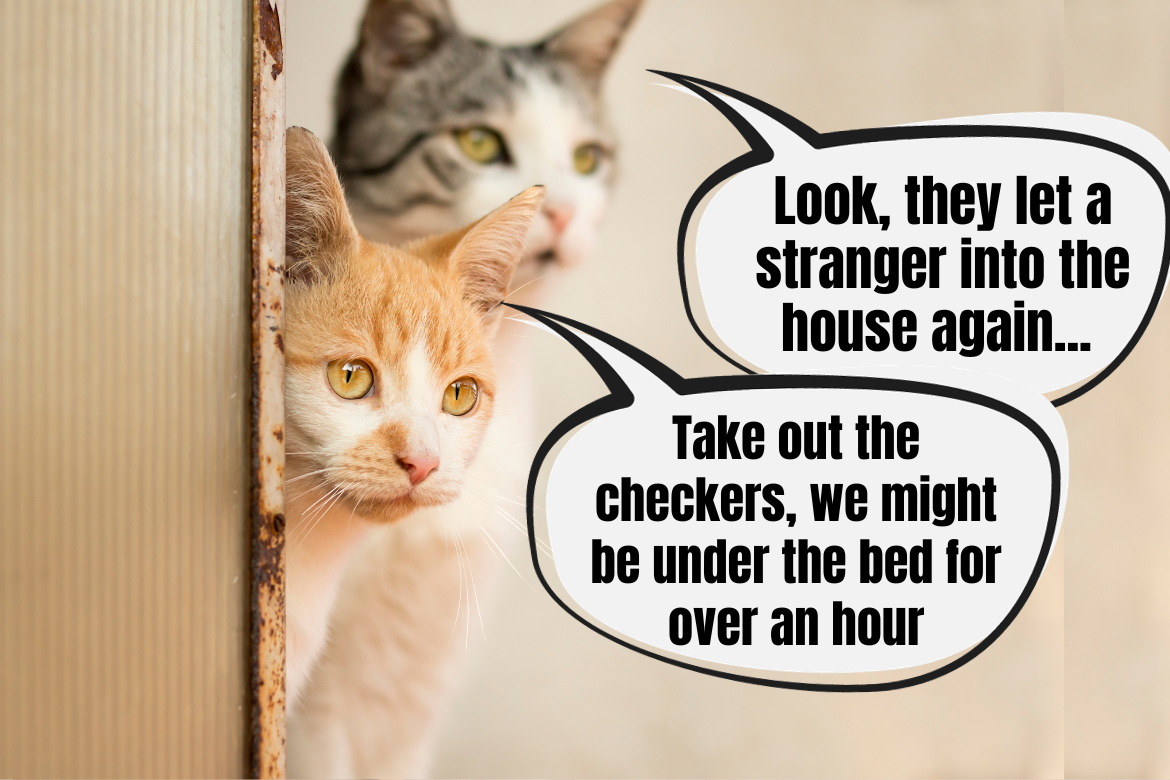Living with a timid cat can be quite a challenge. A cat lacking self-confidence may avoid human contact, spend the whole day hiding, or even resort to aggression as a means of defending themselves against perceived “threats.” But is there a chance for such a scaredy-cat to come out of their shell and become a true, self-confident feline? It won’t be easy, but don’t lose hope, fabCat! Find out what you can do to help your furballs feel comfortable in your home and stop hiding in the corners.
Cats are naturally cautious but not fearful
Cats are incredibly observant of their surroundings. As predators and potential prey for larger predators, they must always remain vigilant. They are not fearful but rather know when to withdraw from a situation and when to defend themselves. Domestic cats, of course, don’t face the same dangers as their wild relatives, but they still need time to adapt to a new environment, other cats, or humans. If they didn’t acquire self-confidence during kittenhood and socialization or had unpleasant experiences in their lives, adult cats may approach their surroundings with more caution. But does this mean they are doomed to be timid cats?
Not necessarily. It is a fact that early-life socialization has a significant impact on a cat’s self-confidence. But not all kitties start on an equal footing in life, and even those from the best breeders can be naturally more timid than their siblings or lose their self-assurance after moving to a new home. Let’s see what we, as Cat Carers, can do to support our cats in becoming self-assured tigers at every stage of their lives.
Ways to build your cat’s self-confidence
Working with a cat should always be based on an understanding of their basic needs and how cats communicate with us. By interpreting a cat’s body language, you can determine whether the cat is highly stressed, frightened, or just cautious but curious. You can find many on cat communication on our blog and online. Also, remember that seeking help from an experienced behaviorist is a good method when you don’t know where to start with a timid cat.
How can we prepare the home and work with the cat safely to gradually build their self-confidence?
- Create a calm environment. Cats feel most comfortable in their own territory, where they can live freely without fear of surprises. They appreciate peace, even when their souls are wild. Therefore, make your home a haven of tranquility for your cat.
How can you achieve this? Create a space where the floor is not the only accessible surface for your cat. Cats often observe their surroundings from a distance, evaluating the situation without participating in it. They love to sit on high shelves, scratching posts, dressers, chairs, or the sofa—anywhere they can withdraw into the shadows and distance themselves from the hustle and bustle. You don’t have to tiptoe around a timid cat, but it’s worth maintaining a relatively peaceful atmosphere without unexpected noises and commotion. The goal is to prepare the cat’s space so they can get used to the normalcy of home life and, at the same time, decide for themselves if they are ready to participate. When they can watch domestic life from a safe distance, it will be easier to convince them that there’s nothing to fear from the household members.
- Embrace minimalism. Scratching posts, cat houses, beds, windowsills, balconies, catwalks around the apartment—while cats appreciate the space you provide, the excess can overwhelm them. Too much territory does not offer comfort because the cat feels the need to monitor every corner. It’s good to practice minimalism from time to time.
How can you do that? Designate one, typically cat-friendly, space in your home. It could be the bedroom, a guest room, or a home office. Let it be a place where your cat naturally enjoys spending time and feels good. At the same time, it should be a space where they can count on silence and peace when needed. This doesn’t mean the cat doesn’t have access to other rooms; it simply gives the cat the choice to retreat to a safe haven when necessary.
In the cat’s space, place scratching posts and beds—they absorb scents, allowing the cat to mark the area as their sanctuary. Hideouts, like the MIA cat house, as well as shelves or the TOBI scratcher on the windowsill or dresser, where the cat can observe the space from a safe distance without hiding, are also crucial. Essential items include food and water bowls, a litter box, and toys. When the cat feels overwhelmed or simply wants to retreat (e.g., during a visit from guests), they will never lose access to their most important resources.
- Give the cat time. Overcoming shyness doesn’t happen overnight. The better environment we create for the cat, and the more patience we exercise in the process, the greater the chance the cat will gradually become more confident. If a stressed cat is hiding under the bed, don’t force them out to show them a new tall scratching post or shelf you’ve installed in the room. Such actions will have the opposite effect.
Be the cat’s biggest cheerleader. Encourage exploration through calm conversation, play, treats, and positive reinforcement. If the cat is afraid of specific people, allow them to become accustomed to the person’s scent, and voice, and gradually let the person offer the cat treats or a meal over time. Giving the cat space and time to think and establish their own boundaries will help the cat realize they can trust us.
- Practice positive reinforcement. Cats learn from experiences. They associate past events with specific individuals or places and try to avoid them in the future. To build your cat’s self-confidence, some situations may require demystification.
For example, if the cat only sees their carrier when a human packs them into it to take them to the vet, they won’t be inclined to enter it willingly in the future—they remember the discomfort it brought them last time. To overcome the cat’s shyness, you will need to create positive associations with the carrier—convince the cat there is no reason to be afraid and that it is safe. This can be achieved by offering the cat their favorite treats or rewards after being in the carrier.
How do you know if a cat is feeling good and self-confident?
A self-confident cat is the ruler of their territory, but they don’t rule with an iron paw. A self-confident cat will greet guests at the door, stroll around the house with their tail up, have a relaxed body posture, and a demeanor that says, “I feel at home here.” They will rub against your legs, watch the vacuum cleaner with keen interest, and, most importantly, won’t feel the need to flee or react aggressively to every new situation. They definitely won’t be a domestic bodyguard, following you around to ensure you don’t get into any trouble 🙂
So, are your furballs, fabCats, among the bold ones who are confident in their territory and their right to use it 100%, or do they tend to retreat into the shadows when any surprises appear on the horizon? We invite you to discuss it in the comments.




